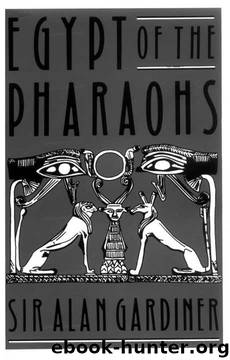Egypt of the Pharaohs: An Introduction by Alan H. Gardiner

Author:Alan H. Gardiner [Alan H. Gardiner]
Language: eng
Format: epub
Published: 2008-09-09T15:21:00+00:00
PLATE XIII
PLATE XIV
SANDSTONE STATUE OF AKHENATEN
From his temple at Karnak. About 13 ft. high
The curtain next rises far away from Thebes and in the sixth year of Akhenaten's reign. El-'Amarna, already mentioned in connexion with the cuneiform tablets found there, was the site selected for a startling innovation by the self-willed but highly courageous monarch. Half-way between Cairo and Luxor the eastern mountains recede leaving a crescent-shaped plain about 8 miles long and 3 broad; here there was ample room for a great city, while on the left bank beyond the Nile a much broader expanse afforded scope for the agriculture which a large population would demand. The name chosen by Akhenaten for his new city was Akhetaten `The Horizon of Aten'. The popularly used modem name Tell elAmarna wrongly combines that of a modern village El-Till in the north with that of the tribe of the Beni 'Amran inhabiting the district, and the more accurate designation El-'Amarna is now generally accepted. Excavations begun by Flinders Petrie in 189i were carried on with only the inevitable interruption caused by the First World War right down to 1937, first by German and then by British archaeologists. I A vast number of brick buildings, or rather of their ground-plans, have been unearthed; of stonework but little remained, but there was a great harvest of valuable antiquities, the most sensational finds being the cuneiform tablets stored in what the bricks used in it call `the Place of Pharaoh's Dispatches'z and the wonderfully lifelike statuary discovered in the atelier of the mastersculptor Dhutmose.3 It is impossible here to enumerate even a portion of the imposing structures that have been identified, palaces, temples, mansions of the functionaries, a workman's village, and desert altars raised in honour of the Aten. To give an idea of the magnitude of some of these edifices it may be mentioned that the great temple of the Aten had a length of little less than aoo yards.
There are, however, all too many signs of the haste with which the constructions were thrown up; the workmanship everywhere is shoddy, though this is often disguised by the beauty of the wonderfully naturalistic pictures of birds and vegetation painted upon plaster walls and floors. Of the greatest possible value for our knowledge of the life here carried on are the sculptured reliefs in the tombs of officials cut into the sides of the eastern hills; the single handed recording of these has been the fine achievement of N. de G. Davies who, however, had everywhere to bemoan the vandalism, both ancient and modern, which had destroyed so much. Lastly must be mentioned the family tomb which Akhenaten caused to be prepared 4 miles away in the eastern desert;' his prematurely deceased second daughter Meketaten was actually buried there, but apparently neither her parents nor any of her sisters. Concerning Akhenaten's own probable fate more will be said later.
The original finding of the site is recounted by Akhenaten himself on great boundary stelae of which
Download
This site does not store any files on its server. We only index and link to content provided by other sites. Please contact the content providers to delete copyright contents if any and email us, we'll remove relevant links or contents immediately.
| Africa | Americas |
| Arctic & Antarctica | Asia |
| Australia & Oceania | Europe |
| Middle East | Russia |
| United States | World |
| Ancient Civilizations | Military |
| Historical Study & Educational Resources |
Black Genesis by Robert Bauval(1588)
Serpent in Sky by John Anthony West(1030)
The Egyptian Book of the Dead by John Romer(811)
The White Nile by Alan Moorehead(752)
100 Hieroglyphs by Barry Kemp(620)
The Emerald Tablets of Thoth the Atlantean by M. Doreal(595)
Nasser by Saïd K. Aburish(563)
Think Like an Egyptian by Barry Kemp(549)
Legends Of The Gods (Illustrated And Annotated Edition) by E. A. Wallis Budge(538)
Lost Technologies of Ancient Egypt: Advanced Engineering in the Temples of the Pharaohs by Dunn Christopher(528)
Egypt - Culture Smart! The Essential Guide to Customs & Culture by Jailan Zayan(512)
Osiris and the Egyptian Resurrection, Vol. 1: 001 by Budge E. A. Wallis(508)
Egyptian Magic (Illustrated And Annotated Edition) by E. A. Wallis Budge(504)
The Ultimate Ambition in the Arts of Erudition by Shihab al-Din al-Nuwayri(492)
The Ultimate Ambition in the Arts of Erudition by al-Nuwayri Shihab al-Din(486)
Egyptian Myths And Mysteries by Steiner Rudolf(475)
Ancient Egyptian Warfare by Ian Shaw(469)
A History of the Middle East: Fourth Edition by Peter Mansfield & Nicolas Pelham(463)
Ramesses by Joyce Tyldesley(449)
